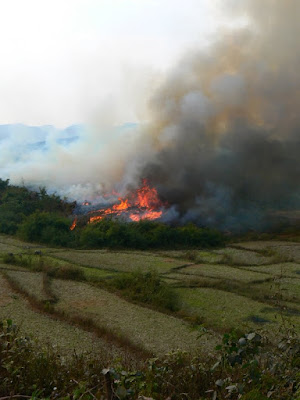
Cooking up the soup over charcoal in Bien's kitchen
Just before we left Laos Sengthian cooked me up some Gaeng Kai Mot Daeng next door at her sisters house. We stayed at that house for a couple of months back in 01 before Creag was born. They have a gas burner but like most in Vientiane prefer the charcoal. It’s cheaper and burns very hot. Smokes up the kitchen a little, oh well.
Geang Kai Mot Dang has to be about as unweird a type of insect food as I’ve ever eaten. The thing it reminded me of the most was the popular Tom Yung Koon that you can buy in any Thai restaurant in the world. The texture of the eggs is a little like soggy puffed rice. No crunchy legs and heads as in most insects.
I didn’t think we would still be around when it was time to get the ant eggs. I’d kind of forgotten that we were even going to eat them, but I did keep a distance from the nest out by our back door. Creagy got bit once, he steered clear of them ever since. Back in November I took a picture of an ant up close and personal.
 Here’s the photo from then. You can see the white nest in the background.
Here’s the photo from then. You can see the white nest in the background.Separating the eggs from the soldier ants requires a bucket of water. When the eggs and nest are in the water the adult ants lie still and even clump up in the water. They aren’t dead just saving their energies. You don’t want to just throw them in the trash or you’ll have a trash can full of angry red ants when you come back. Inevitably some of the ants get left with the eggs, it’s said that’s where the sour taste comes from.
Knowing I don’t like the tiny freshwater fish with millions of tiny bones, Sengthian made the soup with beef as the other ingredient. Tasted pretty good, I always think Lao beef is a little gamey anyway, went well with the sour and slightly fishy taste. I suspect the other ingredients were the usual suspects. Tomatoes, green onions, tamarind leaves, bai kii hoot, hot peppers, kah. No ginger, fish sauce or lime juice.

The greens are Pak Wan up top, Bai Kii Hoot on the plate and Home Paeow below.

Look carefully in the center and you will see an ant that never got picked out of the soup.

















